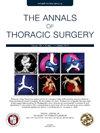Mechanisms of Repair Failure After Mitral Valve Repair Using Chordal Replacement
IF 3.6
2区 医学
Q1 CARDIAC & CARDIOVASCULAR SYSTEMS
引用次数: 0
Abstract
Background
Mechanisms of repair failure after mitral valve repair (MVr) using chordal replacement and annuloplasty for degenerative mitral regurgitation were analyzed.
Methods
All mitral valve reoperations after isolated MVr using solely chordal replacement and annuloplasty for degenerative mitral regurgitation at the German Heart Center Munich (Munich, Germany) were reviewed. This retrospective observational study aimed to analyze mechanisms of repair failure leading to reoperations.
Results
Between 2003 and 2010, a total of 344 patients underwent MVr with chordal replacement and annuloplasty. During a mean follow-up of 9.7 years (range, 0-15.9 years), reoperation on the mitral valve was necessary in 38 (11.0%) cases. Reoperations were performed after a mean of 6.8 years (range, 0-14.1 years). The mechanisms of MVr failure were disease progression (39.5%), technical failure (36.8%), and endocarditis (18.4%). Re-repair was performed in 28.9% and was accomplished using redo annuloplasty (90.9%), chordal replacement (90.9%), resection techniques (27.3%), and leaflet patch reconstruction (9.1%). One patient (2.6%) underwent transcatheter edge-to-edge repair for reoperation. Mitral valve replacement (MVR) was necessary in 63.2%. Redo MVr was mainly performed in cases of technical failure, and MVR was more frequently performed in patients with mitral valve sclerosis. Repeat reoperation was necessary in 3 of 24 cases of MVR and in 2 of 11 cases of redo MVr after a median of 3.8 years (range, 0.01-10.04 years).
Conclusions
MVr using chordal replacement allows a variety of methods for re-repair, including transcatheter solutions. Redo MVr is more often feasible in cases of technical failure, whereas MVR for reoperation is more frequently necessary in patients with mitral valve sclerosis.
二尖瓣修复术后脊索置换修复失败的机理。
背景:研究分析了二尖瓣修复术(MVr)后修复失败的机制:方法:回顾了慕尼黑德国心脏中心因退行性二尖瓣反流而单纯使用弦管置换术和瓣环成形术进行孤立二尖瓣修复术后的所有二尖瓣再手术。这项回顾性观察研究旨在分析导致再手术的修复失败机制:2003年至2010年间,共有344名患者接受了二尖瓣置换术和瓣环成形术。在平均9.7年(0.00 - 15.9年)的随访期间,有38例(11.0%)患者需要再次进行二尖瓣手术。再次手术的平均时间为 6.8 年(0.00 - 14.1 年)。二尖瓣手术失败的原因包括疾病进展(39.5%)、技术失败(36.8%)和心内膜炎(18.4%)。28.9%的患者进行了再修复,修复方法包括重做瓣环成形术(90.9%)、腱索置换术(90.9%)、切除技术(27.3%)和瓣叶修补重建术(9.1%)。一名患者(2.6%)接受了经导管边缘对边缘修补术进行再次手术。63.2%的患者需要进行二尖瓣置换术(MVR)。重做二尖瓣置换术主要用于技术失败的病例,二尖瓣硬化的病例更常进行二尖瓣置换术。3/24例二尖瓣置换术和2/11例重修二尖瓣置换术在中位3.8(0.01 - 10.04)年后需要再次手术:结论:使用脊髓置换术进行中风再灌注可采用多种方法进行再修复,包括经导管解决方案。在技术失败的病例中,重做 MVr 更为可行,而在二尖瓣硬化的病例中,重做 MVR 更为必要。
本文章由计算机程序翻译,如有差异,请以英文原文为准。
求助全文
约1分钟内获得全文
求助全文
来源期刊

Annals of Thoracic Surgery
医学-呼吸系统
CiteScore
6.40
自引率
13.00%
发文量
1235
审稿时长
42 days
期刊介绍:
The mission of The Annals of Thoracic Surgery is to promote scholarship in cardiothoracic surgery patient care, clinical practice, research, education, and policy. As the official journal of two of the largest American associations in its specialty, this leading monthly enjoys outstanding editorial leadership and maintains rigorous selection standards.
The Annals of Thoracic Surgery features:
• Full-length original articles on clinical advances, current surgical methods, and controversial topics and techniques
• New Technology articles
• Case reports
• "How-to-do-it" features
• Reviews of current literature
• Supplements on symposia
• Commentary pieces and correspondence
• CME
• Online-only case reports, "how-to-do-its", and images in cardiothoracic surgery.
An authoritative, clinically oriented, comprehensive resource, The Annals of Thoracic Surgery is committed to providing a place for all thoracic surgeons to relate experiences which will help improve patient care.
 求助内容:
求助内容: 应助结果提醒方式:
应助结果提醒方式:


